Planning a Coast-to-Coast RV Trip With Pets? Here’s What First-Timers Should Know
This article was motivated by a trip I am planning in October, driving coast to coast in a rented RV. We expect it to be exhausting, fun, and certainly an adventure. The inspiration for the trip is to ferry a few adults and a few dogs to a destination in California, starting in Massachusetts. We chose to rent from Cruise America for the reasonable cost and their customer support system, which is well set up for a trip such as this.
We have driven a Class C before (4 times to be exact) but are by no means experts. This guide is for all us newbies. If you have never “gone RVing”, maybe now’s the time?
You CAN Do It!

Taking your first road trip in a Class C RV can be equal parts exhilarating and overwhelming. These mid-sized homes on wheels offer just enough creature comforts to keep you cozy, but they also come with systems and quirks that first-timers often learn about the hard way. Add pets to the mix, and it gets even more interesting.
Whether you’re taking a cross-country journey or a weekend escape, here’s what you need to know before you go.
Understand What a Class C RV Really Is

A Class C RV is built on a truck or van chassis with an over-cab sleeping area, making it more manageable to drive than a bus-style Class A but roomier than a Class B camper van. Most Cruise America rentals range from 25 to 30 feet and include a sleeping loft, small kitchen, bathroom, and dinette. It feels like a compact studio apartment on wheels.
Class C RVs are popular among beginners because they’re easy to maneuver and don’t require a special license. Still, they’re bigger than what most people are used to driving—especially when turning or backing up—so allow yourself a little practice time before tackling interstates or city streets.
Yes, the Fridge Works While Driving—But It Runs on Propane

Most RV refrigerators are absorption-style, meaning they don’t use a compressor like your home fridge. Instead, they rely on either propane gas or electricity to operate.
When you’re plugged in at a campsite, the fridge uses AC power. When you’re driving or parked without hookups (boondocking), it switches to propane.
Pay Attention!

It’s a clever system, but there are some key things to remember:
- You must manually switch it to “propane” or “auto” mode, depending on the model.
- The fridge needs to be level to work properly when parked—especially if running on propane.
- Always turn off the propane before refueling the RV to avoid a fire hazard.
So yes, your groceries will stay cold while driving, but it’s important to use the system safely and understand what mode it’s in.
Can Someone Sleep While You Drive? Technically Yes, But Don’t

While it’s not illegal in many states for passengers to ride in the back of a motorhome, sleeping back there is not recommended for safety reasons. Most beds in Class C RVs do not have seatbelts, and the over-cab bunk in particular can be dangerous if you brake suddenly or take a sharp turn.
If you’re traveling with another adult, trade off driving and resting—but only while the RV is stopped. Consider pulling over at rest stops, Walmart lots, or Cabela’s to nap safely.
Boondocking Means No Hookups—And You Need to Plan Ahead
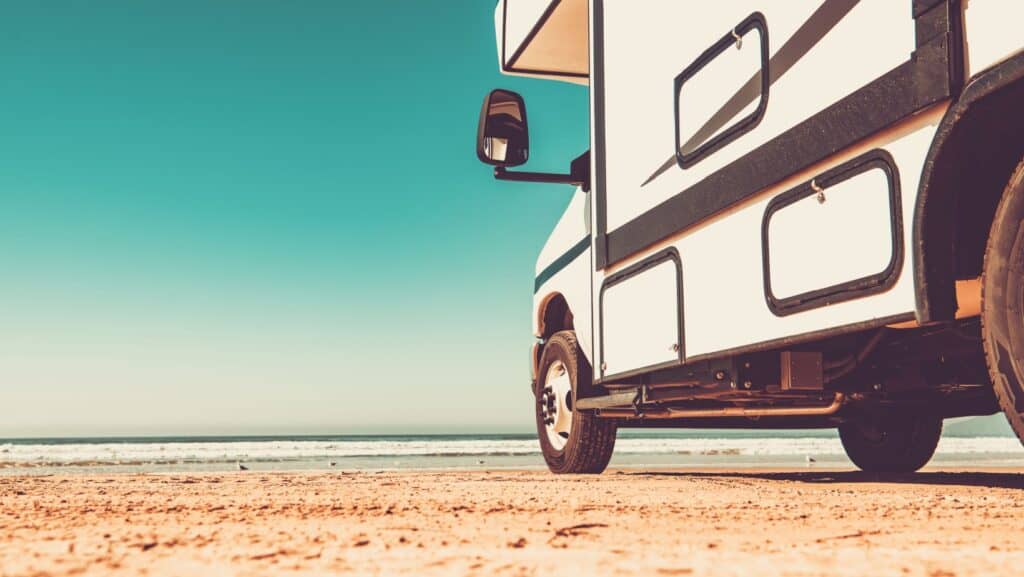
Boondocking, or dry camping, means staying somewhere without hookups for water, electricity, or sewer. Class C RVs are equipped to handle short boondocking trips thanks to their onboard tanks and batteries, but you need to manage resources wisely.
- Fill your fresh water tank before you arrive. But use this for showering and the toilet. We always bring bottles water for drinking, toothbrushing and cooking.
- Conserve power by using lights and appliances sparingly.
- Use campground apps like Campendium or iOverlander to find free overnight spots with space for RVs.
Pro Tip: Some national forests, Bureau of Land Management (BLM) land, and even certain Cabela’s and Cracker Barrels allow overnight parking for free; just make sure to call ahead and confirm.
Where Do You Dump the Waste Tanks?

Your RV has two waste tanks: gray (for sink and shower water) and black (for the toilet). When either tank gets full, you’ll need to find a dump station to empty them.
Most full-service RV parks have dump stations. If you’re boondocking, you can find dump sites at many travel centers, state parks, and even some gas stations. Use the RV Dump Stations app or websites like Sanidumps.com to locate them.
Dumping is smelly but not hard. The basics are: hook up the hose, empty the black tank first, then the gray (to help rinse the hose), and rinse everything thoroughly. The first time we did this, I was nervous, but it ended up being easier than expected
Where Can You and Your Dog Sleep Safely?
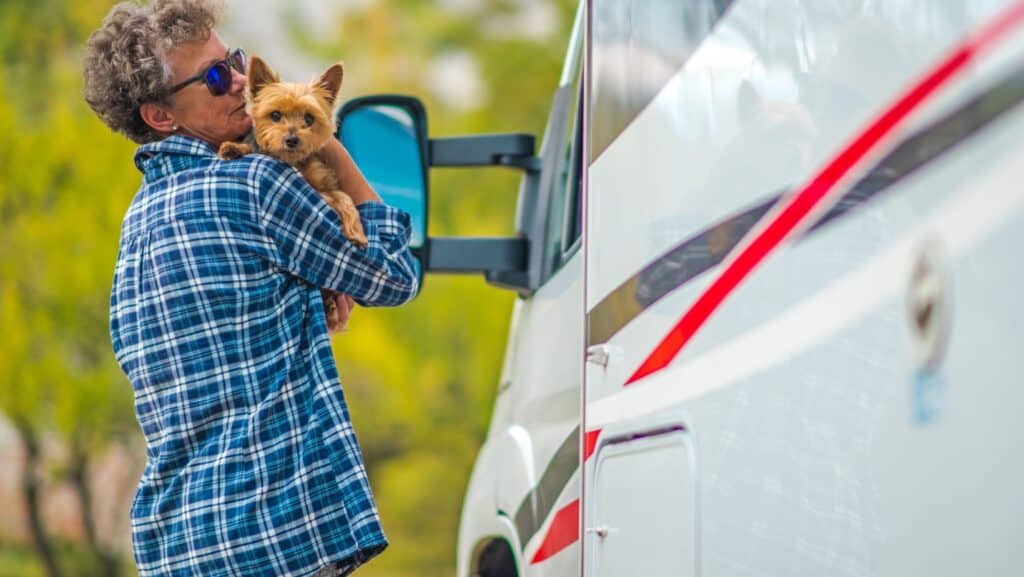
Class C RVs are dog-friendly by design, and many first-time RVers bring their pups along. Look for campgrounds with fenced dog parks, like those found at KOAs (called KampK9® areas), or places with open trails where leashed dogs are welcome.
State and city parks, fairgrounds, and privately-owned campgrounds often offer full hookups and open space for dogs to stretch their legs.
Get Tech!

To help keep your dog safe and comfortable in the RV, consider investing in pet-specific tech like Waggle, a temperature and humidity monitor that sends real-time alerts to your phone if the RV gets too hot or cold. For more robust remote monitoring, devices like MarCELL track temperature, power outages, and humidity—ideal for peace of mind if you need to leave your pet inside while running errands or sightseeing. Both tools are especially useful when traveling through areas with unpredictable weather or limited shade.
And by the way, we have our dogs crated while the vehicle is moving and we suggest you do the same. Always safety first. Taking it one step further, we personally never leave the dogs alone, even in a parked RV, ESPECIALLY if you do not have temperature monitoring, but also just for general safety.
You Can Mix in a Few Cheap Hotels, Too

Want a real shower and a non-camper bed for a night or two? Some dog-friendly hotel chains like La Quinta, Red Roof Inn, and Motel 6 welcome pets and offer inexpensive rooms off interstates.
This can be a great way to reset, especially on longer trips. Just double-check pet policies (many allow dogs under 50 pounds for free, but others may charge a fee).
Fuel Costs Add Up—Plan Accordingly
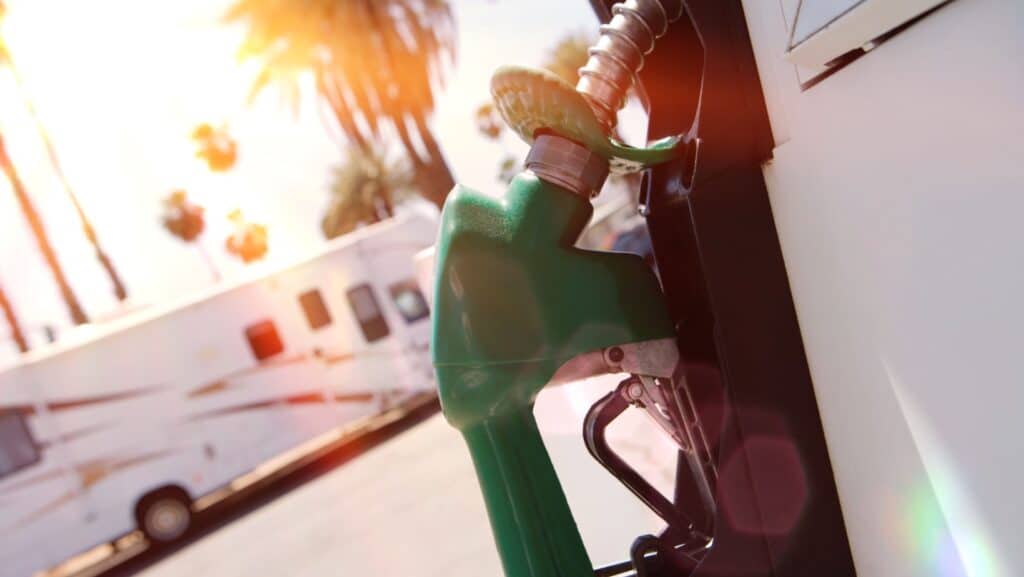
Class C RVs aren’t known for their fuel efficiency. If you’re averaging 8 miles per gallon and gas is $3.50 per gallon, a 600-mile day costs over $260 in fuel. Use apps like GasBuddy to find the cheapest stations on your route, and try to limit backtracking or detours unless they’re really worth it.
Also keep in mind that using your generator (to run A/C or the microwave while boondocking) burns fuel from your main gas tank—so keep an eye on levels.
Driving an RV Is Different—Leave Room for Error

You’ll need to take wide turns, brake sooner, and avoid low-clearance roads or bridges. Your Class C is likely over 11 feet tall and 25–30 feet long, so pay attention to clearance signs and avoid drive-thrus and fast food lots that look tight.
Most RVers use apps like RV Life Trip Wizard or RV Parky to map safe routes and find parking. GPS units made for RVs can also help avoid low bridges and restricted roads.
The Learning Curve Is Real—But Totally Worth It
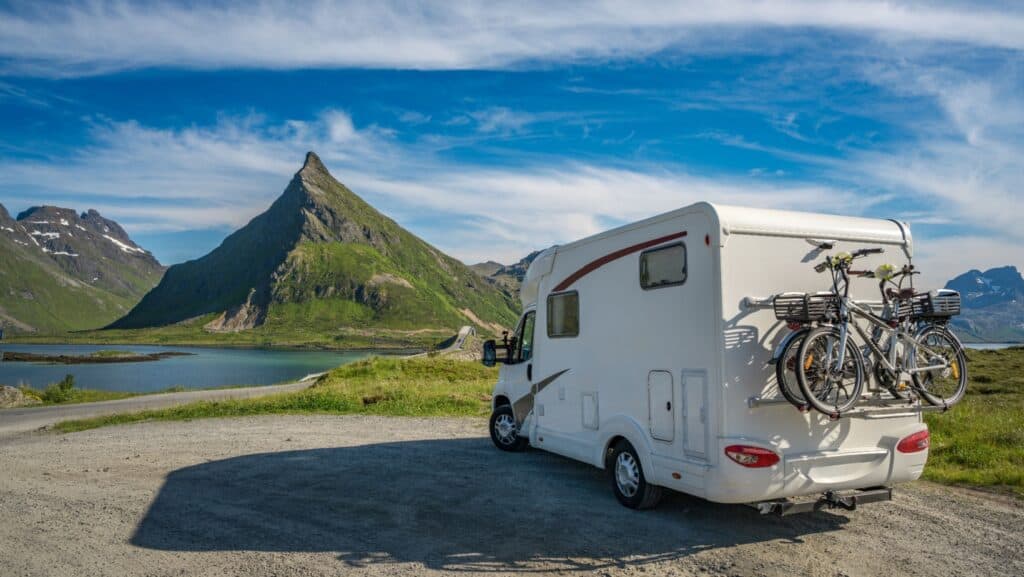
Your first RV trip might come with a few missteps: forgetting to latch a cabinet, overfilling the gray tank, or discovering the water pump was left on. That’s all part of the experience.
The best way to learn is by doing. You’ll find a rhythm quickly: where to stop, how to level the rig, when to dump tanks, and how to pack so things don’t fly everywhere when you hit a bump. And nothing beats pulling off the road, opening the side door, and cooking a quick lunch with your dog snoozing at your feet.
Oops! 5 Common Rookie Mistakes in a Class C RV
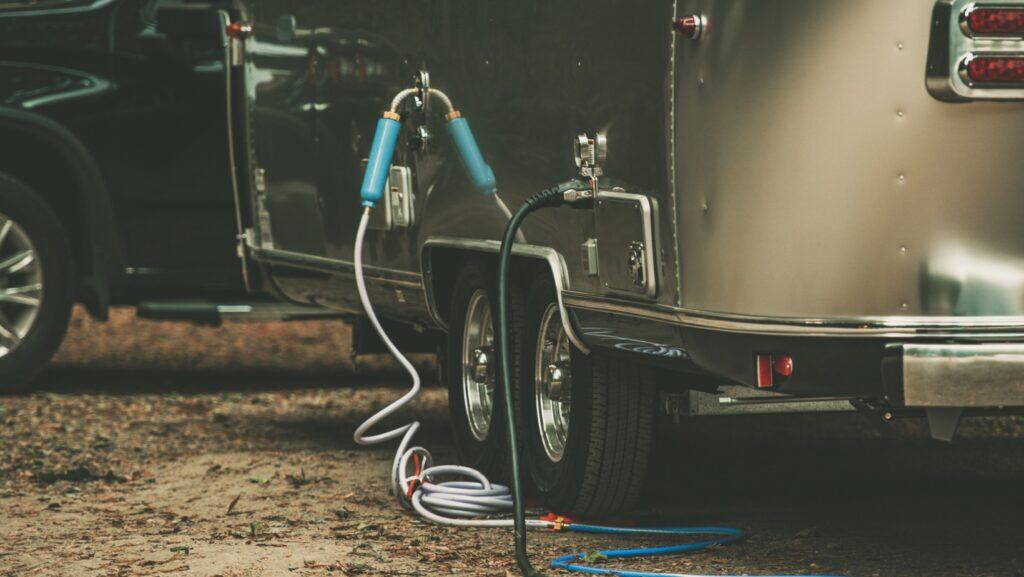
Even seasoned RVers have stories of small disasters, and first-timers are practically guaranteed to learn something the hard way. Here are five of the most common pitfalls—and how to avoid them:
1. Driving Away Still Plugged In: It happens more than you’d think. Always do a “walk-around” before pulling out to double-check all hookups are disconnected and compartment doors are latched.
2. Underestimating Your Height (and Width): Know your exact height (usually around 11–12 feet) and post it on your dashboard. Same goes for your width—keep extra space when navigating tight lanes, driveways, or construction zones.
3. Not Leveling Before Using the Fridge: If your RV isn’t level when parked, your absorption fridge (especially on propane mode) won’t function properly—and could even be damaged.
4. Forgetting to Close the Roof Vents: Always close roof vents before driving, and if you’re expecting rain, check that your skylight is sealed, too.
5. Leaving Loose Items to Fly: That olive oil bottle? A missile. Those bananas? Smashed into the dinette. Always secure loose items before driving, especially in the kitchen and bathroom. Bungee cords, cabinet latches, and nonslip shelf liners are your new best friends.
Ready to Hit the Road?
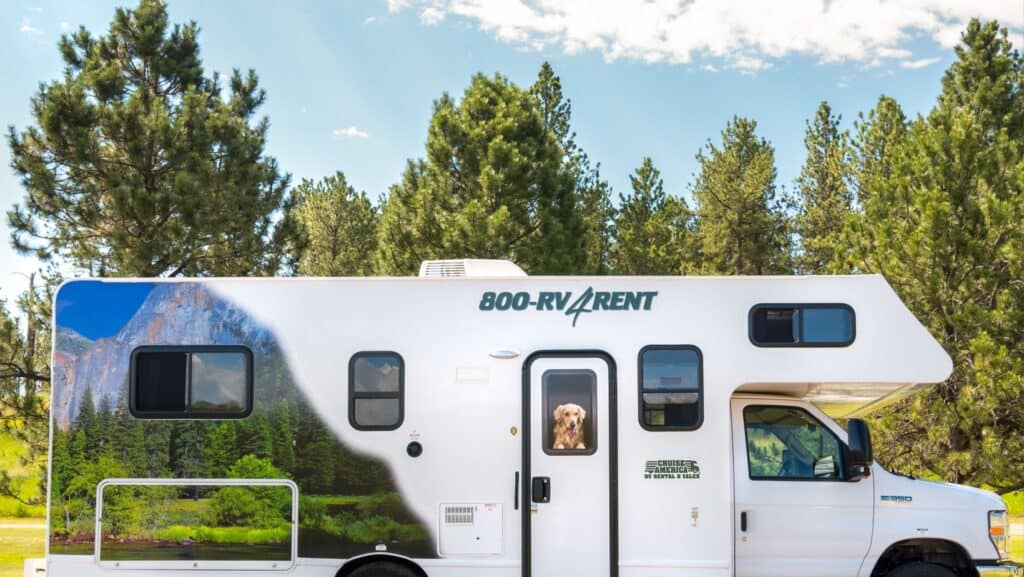
Start small. Plan your route with room for flexibility. Make campground reservations where needed, especially near popular areas. And remember—RV life isn’t about perfection. It’s about the journey, the scenery, and the freedom to stop wherever you want. With a little prep, a lot of snacks, and a leash for your four-legged co-pilot, your first Class C RV adventure can be unforgettable in the best way.
How To Travel With Your Dog: Planes, Trains, Automobiles – and Boats!

READ: How To Travel With Your Dog: Planes, Trains, Automobiles – and Boats!
Traveling with your dog can be a rewarding experience, but it requires careful planning and consideration to ensure safety and compliance with various regulations. Whether you are traveling by car, plane, train, boat, or subway, understanding the laws, safety measures, and best practices is crucial. We have what you need to know for a smooth and enjoyable journey with your canine companion. And if you have the bucks for private plane travel, we have the details about how you and your pooch can travel together in style.
Join Us

Join us on this empowering journey as we explore, celebrate, and elevate “her story.” The Queen Zone is not just a platform; it’s a community where women from all walks of life can come together, share their experiences, and inspire one another. Welcome to a space where the female experience takes center stage. Sign up for our newsletter so you don’t miss a thing, Queen!






